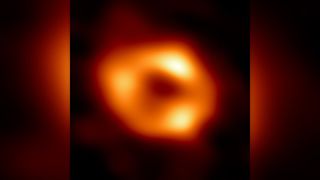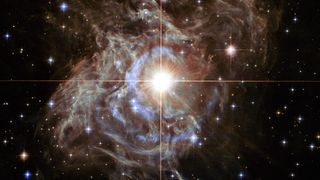The expansion rate of the universe is accelerating across the cosmos, driven by a mysterious force known as dark energy – but perhaps not at the edges of black holes, new research suggests.
Rather than implying that dark energy does not act at the boundaries of black holes, this idea suggests that this mysterious force that dominates the universe is the only energy at stake at event horizons.
The concept could help solve a long-standing problem in cosmology called the “Hubble tension,” which results from radically different estimates of the expansion rate of the universe, known as the Hubble constant or Hubble parameter.
Perhaps more importantly for non-theoretical physicists, this research means that black holes, their outer boundaries, or “event horizons,” and the expansion of space caused by dark energy may all be stranger and harder to understand than we feared.
Related: Forbidden black holes and ancient stars hide in these ‘tiny red dots’ (image)
This mind-boggling new idea was suggested by theoretical physicist Nikodem Poplawski of the University of New Haven in Connecticut. According to him, even though the space around black holes is expanding, albeit differently from the rest of the cosmos, the black holes themselves are not growing.
“The rate of expansion of the universe at each black hole’s event horizon is constant, but the size of the event horizon, and thus the black hole itself, does not increase as the universe expands,” Poplawski told Space.com. “You might ask: How is it possible that the event horizon is not expanding, but space is expanding within it? That’s because the expansion of space is causing points very close to the event horizon to move away from it.”
Poplawski added that some people have suggested that black holes could grow and increase in mass without any accretion of matter due to the expansion of the universe. He argued that his results show that this explanation for black hole growth, particularly for supermassive black holes that grew incredibly quickly in the early universe, is not valid.
Almost black holes?
Researchers first imagined black holes as solutions to Einstein’s 1915 theory of gravity, called general relativity, proposed by, among others, German physicist and astronomer Karl Schwarzschild.
General relativity states that objects with mass cause the very fabric of space and time to “warp” into a single entity called spacetime. The greater the mass, the greater the warping of spacetime it causes. Since gravity results from this warping, this explains why the more mass an object has, the greater the gravitational influence it exerts on its surroundings.
Black holes were born from the idea of an infinite amount of mass concentrated in an infinitesimal space, called a singularity. According to the equations of general relativity, this singularity, where all physics breaks down, would be bounded by an unphysical surface from which even light could not travel fast enough to escape. This is the event horizon, and its existence means that nothing escapes from a black hole. Thus, we can never hope to “see” what is inside a black hole.
Due to the extreme warping of time around a black hole, we can never hope to see the event horizon itself.
“The event horizon forms after an infinite amount of time has passed on Earth,” Poplawski explained. “What we observe are not black holes, but ‘near black holes.'”
So when a star collapses at the end of its life to give birth to a black hole, what we see is not the black hole but the final moment of this transformation. As if this concept weren’t already strange enough, Poplawski thinks that event horizons are even stranger: dark energy exists there, but the space around the event horizons seems to simply ignore it.

“The expansion rate of the universe, the Hubble parameter, is constant and can be positive or zero at the event horizon of black holes,” Poplawski said. “That must be the case, because if the expansion rate of the universe at the event horizon were not constant, the pressure and curvature of spacetime would be infinite. It would not be measurable; therefore it would not be physical.”
As puzzling (and confusing) as Poplawski’s theory is, it might actually solve a problem that has puzzled scientists for decades.
Related: Our Expanding Universe: Age, History, and Other Facts
End of problems with Hubble?
In the late 1990s, two separate teams of astronomers used measurements of the distances of Type Ia supernovae to determine that not only is the universe expanding, as evidence collected by Edwin Hubble in the early 20th century had shown, but that this expansion is also accelerating.
The term “dark energy” was coined at that time to describe the aspect of the universe that is causing this acceleration. Since then, scientists have determined that in the current epoch of the cosmos we live in, dark energy dominates dark matter and everyday matter, accounting for about 68% of the energy and matter in the universe.
Currently, the simplest explanation for dark energy is the “cosmological constant,” a measure of the energy density of the vacuum. However, as you’ve probably figured out by now, nothing is really simple in cosmology.

When the value of the cosmological constant is calculated from quantum field theory, the result is greater than what is obtained when observing distant type Ia supernovae and stars that alternate in brightness, called Cephid variables, both known as “standard candles” because of their usefulness in measuring cosmic distances.
By some estimates, the difference between the two values can be as high as 121 orders of magnitude, or 10 followed by 120 zeros. No wonder some physicists consider the cosmological constant “the worst prediction in the history of physics.”
This problem, called the Hubble tension, has only gotten worse as quantum field theory and cosmology have improved and astronomy has become more robust; surprisingly, the values have continued to diverge.
The only way for both estimates of the Hubble parameter to be correct would be if the expansion rate of the universe is not proceeding uniformly across the cosmos, with some regions expanding much faster than others.
One idea is that our galaxy, the Milky Way, is located in an underdense “bubble” of the universe—a “Hubble bubble,” if you will—that affects local distance measurements, causing them to provide a low value of the Hubble parameter. On the other hand, quantum field theory is not limited by the local universe and considers the entire cosmos, thus providing a high value that is averaged over all space.
Poplawski’s hypothesis now offers an alternative explanation, according to which certain regions of the cosmos could be accelerating at different rates.
“The expansion rate is the same at all event horizons, but in other parts of the universe it depends on matter and spatial curvature, so it is different,” he explained. “Therefore, different parts of the universe have different expansion rates. This explains the observed Hubble tension.”
Could Poplawski’s theory that universal expansion moves at a constant rate at event horizons be verified by observation using astronomy?
Unfortunately, he thinks this is unlikely. Standard candles like Type Ia supernovae and Cephid variable stars do not exist at the edge of event horizons. This means that astronomical methods of determining the Hubble parameter are virtually useless in this case.
Also, there’s this whole time warp thing to consider, and the fact that light can’t escape a black hole. The only way to measure the Hubble parameter here might be to take a one-way trip into the black hole.
“Strictly speaking, we cannot measure the Hubble parameter at the event horizon, because when we see the black hole, the horizon has not yet formed,” Poplawski said. “However, an observer falling into a black hole will cross the event horizon in a finite time and could theoretically measure the Hubble parameter as they cross it.”
“However, they could not send this information back to Earth, because nothing can escape from the event horizon into space.”
Poplawski therefore believes that unless a revolutionary method of measuring the Hubble parameter is developed, the jealously guarded secrets of black holes will remain shrouded in mystery.
Poplawski’s research is presented in a pre-peer-reviewed paper on the preprint website arXiv.